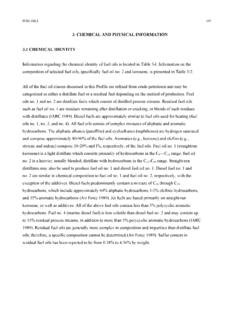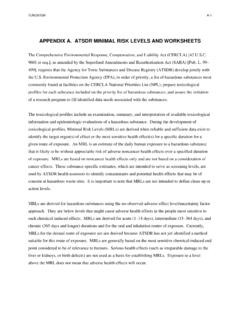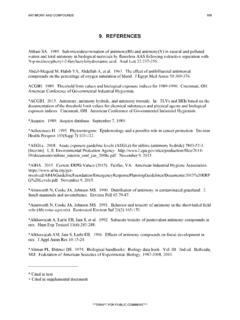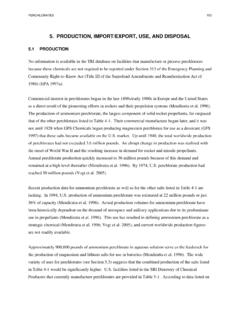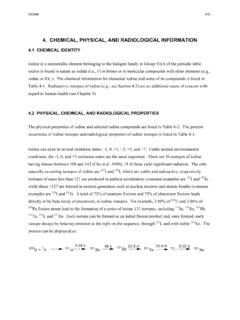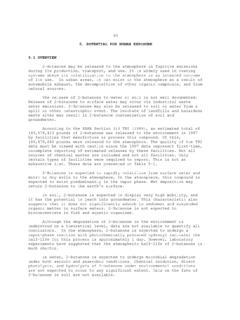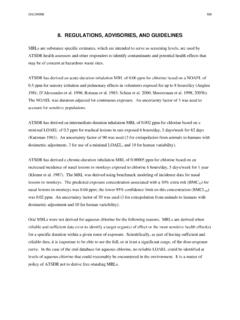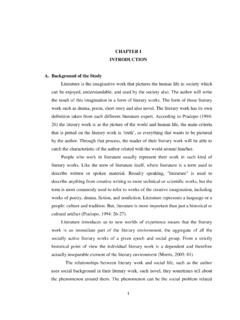Transcription of Principles of Community Engagement (Second Edition) …
1 Community Engagement : Definitions and Organizing Concepts from the Literature chapter 1. Community Engagement : Definitions and Organizing Concepts from the Literature Donna Jo McCloskey, RN, PhD, (Chair), Mary Anne McDonald, DrPH, MA, Jennifer Cook, MPH, Suzanne Heurtin-Roberts, PhD, MSW, Stephen Updegrove, MD, MPH, Dana Sampson, MS, MBA, Sheila Gutter, PhD, Milton (Mickey) Eder, PhD. introduction . Over the last two decades, research and practice in health promotion have increasingly employed Community Engagement , defined as the process of working collaboratively with and through groups of people affiliated by geographic proximity, special interest, or similar situations to address issues affecting the well-being of those people (Centers for Disease Control and Prevention [CDC], 1997, p 9) In general, the goals of Community Engagement are to build trust, enlist new resources and allies, create better communica- tion, and improve overall health outcomes as successful projects evolve into lasting collaborations (CDC, 1997; Shore, 2006; Wallerstein, 2002).
2 The rationale for Community -engaged health promotion, policy making, and research is largely rooted in the recognition that lifestyles, behaviors, and the incidence of illness are all shaped by social and physical environ- ments (Hanson, 1988; Institute of Medicine, 1988) This ecological view is consistent with the idea that health inequalities have their roots in larger 3. socioeconomic conditions (Iton, 2009) If health is socially determined, then health issues are best addressed by engaging Community partners who can bring their own perspectives and understandings of Community life and health issues to a project And if health inequalities are rooted in larger socioeconomic inequalities, then approaches to health improvement must take into account the concerns of communities and be able to benefit diverse populations . The growing commitment to Community Engagement is reflected in a num- ber of major federal initiatives, including the Clinical and Translational Science Awards (CTSA) program and the Research Centers in Minority Institutions program of the National Institutes of Health (NIH), CDC's Prevention Research Centers, and the practice-based research networks of the Agency for Healthcare Research and Quality (AHRQ) In addition, new work by AHRQ highlights the potential benefits of engaging patients and families in the redesign of medical care (Scholle et al , 2010) Healthy People 2020, which lays out our national health objectives, emphasizes collabora- tion among diverse groups as a strategy to improve health.
3 This emphasis on Community Engagement has encouraged health profession- als, Community leaders, and policy makers to imagine new opportunities as they face new challenges (Doll et al , 2008) This initial chapter addresses concepts, models, and frameworks that can be used to guide and inspire efforts to meet those challenges It does not pretend to cover all the available and relevant social science and public health litera- Moreover, Community ture, but it provides an overview of some of the critical organizing Engagement is grounded in concepts that shed light on the idea of Community and the practice of Community Engagement Sociology, political science, cultural the Principles of Community anthropology, organizational development, psychology, social organization: fairness, justice, work, and other disciplines have all contributed to the develop- ment and practice of Community Engagement (Minkler et al , 2009).
4 Empowerment, participation, and Moreover, Community Engagement is grounded in the Principles self-determination of Community organization: fairness, justice, empowerment, par- ticipation, and self-determination (Alinsky, 1962; Ch vez et al , 2007; Freire, 1970; Wallerstein et al , 2006) The interdisciplinary background offered in this chapter provides a rich array of concepts for stakeholders, such as public health agencies, practice-based researchers (in 4. clinics, agencies, after-school programs, and nursing homes), policy makers, and Community organizations, to draw from when developing partnerships in Community Engagement . This chapter is more extensive than the corresponding chapter in the first edition, reflecting growth in the literature and the increased collective experience in Community Engagement . CONCEPTS OF Community . There are many ways to think about Community We will explore four of the most relevant, each of which provides different insights into the process of Community Engagement .
5 Systems Perspective From a systems perspective, a Community is similar to a living creature, comprising different parts that represent specialized functions, activities, or interests, each operating within specific boundaries to meet Community needs . For example, schools focus on education, the transportation sector focuses on moving people and products, economic entities focus on enterprise and employment, faith organizations focus on the spiritual and physical well-being of people, and health care agencies focus on the prevention and treatment of diseases and injuries (Henry, 2011) For the Community to function well, each part has to effectively carry out its role in relation to the whole organ- ism. A healthy Community has well-connected, interdependent sectors that share responsibility for recognizing and resolving problems and enhancing its well-being Successfully addressing a Community 's complex problems requires integration, collaboration, and coordination of resources from all parts (Thompson et al , 1990) From a systems perspective, then, collabora- tion is a logical approach to health improvement.
6 Social Perspective A Community can also be defined by describing the social and political networks that link individuals, Community organizations, and leaders Understanding these networks is critical to planning efforts in Engagement For example, 5. tracing social ties among individuals may help Engagement leaders to iden- tify a Community 's leadership, understand its behavior patterns, identify its high-risk groups, and strengthen its networks (Minkler et al , 1997) chapter 6 explores this approach to understanding a Community in greater depth . Virtual Perspective Some communities map onto geographically defined areas, but today, indi- viduals rely more and more on computer-mediated communications to access information, meet people, and make decisions that affect their lives (Kozinets, 2002) Examples of computer-mediated forms of communication include email, instant or text messaging, e-chat rooms, and social networking sites such as Facebook, YouTube, and Twitter (Flavian et al , 2005) Social groups or groups with a common interest that interact in an organized fashion on the Internet are considered virtual communities (Rheingold, 2000; Ridings et al , 2002) Without question, these virtual communities are potential partners for Community -engaged health promotion and research chapter 6 focuses on social networking and expands on the virtual perspective.
7 Individual Perspective Individuals have their own sense of Community membership that is beyond the definitions of Community applied by researchers and Engagement leaders . Moreover, they may have a sense of belonging to more than one Community . In addition, their sense of membership can change over time and may affect their participation in Community activities (Minkler et al , 2004) . The philosopher and psychologist William James shed light on this issue in his writings James thought it important to consider two perspectives on identity: the I, or how a person thinks about himself or herself, and the me, or how others see and think about that person Sometimes these two views agree and result in a shared sense of an identity, but other times they do not People should not make assumptions about identity based on appearance, language, or cultural origin; nor should they make assumptions about an individual's perspective based on his or her identity (James, 1890) Today, the multiple communities that might be relevant for any individual including families, workplace, and social, religious, and political associations suggest that individuals are thinking about themselves in more complex ways than was the norm in years past.
8 6. The eligibility criteria that scientists, policy makers, and others develop for social programs and research projects reflect one way that people perceive a group of proposed participants, but how much those criteria reflect the participants' actual view of themselves is uncertain Practitioners of com- munity Engagement need to learn how individuals understand their identity and connections, enter into relationships, and form communities . WHAT IS Community Engagement ? In the first edition of Principles , the authors developed a working definition of Community Engagement that captures its key features: the process of working collaboratively with and through groups of people affiliated by geographic proximity, special interest, or similar situations to address issues affecting the well-being of those people It is a powerful vehicle for bringing about environmental and behavioral changes that will improve the health of the Community and its mem- bers It often involves partnerships and coalitions that help mobilize resources and influence systems, change relationships among partners, and serve as catalysts for changing policies, programs, and practices (CDC, 1997, p 9).
9 Community Engagement can take many forms, and partners can include organized groups, agencies, institutions, or individuals Collaborators may be engaged in health promotion, research, or policy making . Community Engagement can also be seen as a continuum of Community Engagement can Community involvement Figure 1 1 below, modified from a dia- gram originally drawn by the International Association for Public take many forms, and partners Participation, illustrates one way of thinking about such a con- can include organized groups, tinuum Over time, a specific collaboration is likely to move along this continuum toward greater Community involvement, and any agencies, institutions, or given collaboration is likely to evolve in other ways, too Most individuals. Collaborators may notably, while Community Engagement may be achieved during a time-limited project, it frequently involves and often evolves into be engaged in health promotion, long-term partnerships that move from the traditional focus on a research, or policy making.
10 Single health issue to address a range of social, economic, political, and environmental factors that affect health . 7. Increasing Level of Community Involvement, Impact, Trust, and Communication Flow Outreach Consult Involve Collaborate Shared Leadership Some Community More Community Better Community Community Involvement Strong Bidirectional Involvement Involvement Involvement Relationship Communication flow is Communication flows Communication flows to Communication flows bidirectional Final decision making is from one to the other, to the Community and then both ways, participatory at Community level. inform back, answer seeking form of communication Forms partnerships with Community on each Entities have formed Provides Community with Gets information or feed- Involves more participa- aspect of project from strong partnership information. back from the Community .
